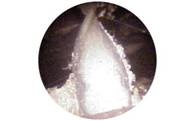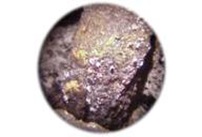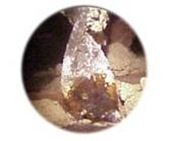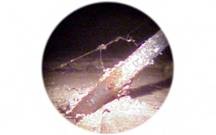Boroscopes have been in use across Yorkshire for a number of years. However, they take some getting used to and it’s not surprising that some find it hard to comprehend what a surveyor is describing in his report. This can be especially disconcerting, if a customer is potentially facing an expense for remedial work, especially if there is apparently no visible defect in the building. The client is left to rely on the surveyor’s integrity and expertise – risky?
I wrestled with this issue surveying in and around Leeds and Sheffield until 2002, when I researched an effective way of using endoscopic photography – obtaining digital images through the boroscope, so you can see what I see and get a much better understanding of your report.
This method is particularly useful for wall tie corrosion inspections, tie orientation and embedment inspections too. Property buyers find it invaluable when they are faced with convincing a sceptical vendor that there really is a hidden defect, which needs repairing. Conversely, vendors find it useful in showing that there is no defect at all, when perhaps a buyer or another specialist firm has implied the opposite (I’ve found this in happening on wall tie surveys in Sheffield, Leeds and across Yorkshire – it really confuses consumers).
Corrosion isn’t the only area this helps me with, recent survey projects include helping a well known house builder to prove that the wall ties in his freshly completed development met embedment and orientation requirements. The need for this followed a ‘one-off’ error by one of our clients’ sub-contractors, on a site in Wakefield, West Yorkshire, which initially threw doubt on the entire development – I was able to help, by getting real credible images and briefing the client of the correct standards which applied.
Architects, engineers and surveyors use this service extensively, because they value evidence – above opinion.
The following is my short guide on wall tie corrosion – seen through my boroscope…and photographed for customers in Yorkshire.
 Even quite new galvanised ties may exhibit slight corrosion. This is from a house in Pontefract near Wakefield, built in the 1980’s. Notice the very shiny and sound surface, with slightly dull zinc in places and very early stage zinc oxide deposits (white patches). This is no cause for concern.
Even quite new galvanised ties may exhibit slight corrosion. This is from a house in Pontefract near Wakefield, built in the 1980’s. Notice the very shiny and sound surface, with slightly dull zinc in places and very early stage zinc oxide deposits (white patches). This is no cause for concern.
This is the other end of the corrosion scale. A very heavily rusted fishtail wall tie tie inspected and photographed at a pre war property in Wakefield. This corrosion has been worsened by the lack of any galvanising in the first place and corrosive black ash mortar. Notice the rough surface, caused by lamination of the ferric oxide.
Galvanised ties corrode to this extent, even without the assistance of black ash mortar. A sure sign of poor galvanising application, note that ij this boroscope image, from a wall tie survey in Leeds, the zinc (top of image), gradually decays; first to zinc oxide (white deposits) and then on to real red rust as the metal is exposed (ferric oxide). This is a severe and urgent issue. It is not just a case of the tie losing strength; the corrosion breaks the intimate bond between the mortar and the tie. In effect, failure can occur whilst the tie is still strong – in high winds the outer skin may pull away from the ties, leaving the rust behind; like casting off an old oversize mitten.
Galvanised wire ties rust also. Once more due to poor zinc thickness, in this case from a post war house in Harrogate near Leeds. I have found worse corrosion than this on ties supplied and installed to builders as recently as the 1970’s. The problem with these is that the small section is rarely sufficient to cause expansion cracking – the first sign of a problem could be a bowing, cracking wall or worse.
Surveyors beware ! The wall tie on the right, inspected through a boroscope on a house in Sheffield would class as reference level 5 using the visual grading of the condition of steel ties table in BRE 401. However, be careful; where black ash is present, as in this case, more severe corrosion is typical in the bed joint; hidden from the boroscope. Going by this image , a surveyor could be forgiven for marking this house down for 5 year inspection……the following image reveals the full extent of the decay.
I’ve removed a brick from the external leaf, which reveals the whole tie. Look closely below; the section of tie in the cavity is free of rust – only a white ‘tell tale’ of zinc oxide indicates a problem. If aggressive mortar is present DO NOT us a boroscope as evidence that there is no significant corrosion problem. Checking the tie in the external leaf bed-joint is essential. In this case our client was buying the House in the Hunters Bar area of Sheffield and was able to negotiate a substantial discount from the house price, to cover the cost of the essential cavity wall tie replacement

Remember: The acidic effect of black ash mortar is usually confined to the section of metal which is in intimate contact with it. If in doubt call for advice, or better still, book a survey.
Please bear in mind that a boroscope is a dumb piece of equipment and in the hands of the inexperienced or untrained, it’s about as useful as a stethoscope is to a Plumber, or a blow torch is to a Doctor. I’ve been using this equipment weekly since 1986 and I am still learning more every month….
DryRot.
If you need a wall tie report on a house or commercial building in Yorkshire why not try my little firm? Brick-Tie Limited, est 1986.
All the photographs in the above post represent years of work – please do not copy – they are the copyright of Brick-Tie Limited (2002 to 2009) and all rights are reserved – yes, that applies to any wall tie ‘specialists’, builders, damp proofers, surveyors or anyone else – be warned, rigorous legal action will be taken if you infringe our rights. Universities, collages, trade association or other educational establishments should contact Brick-Tie limited for free permission to copy, print or replicate for none commercial purposes.



